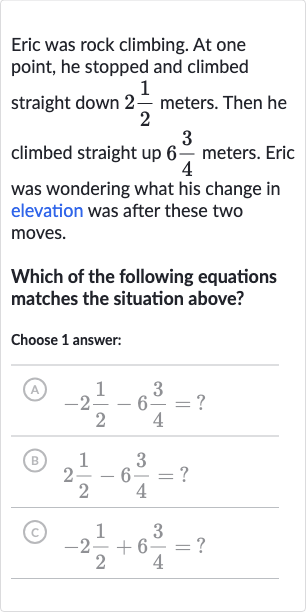AI tutor
Welcome to Bytelearn!
Let’s check out your problem:

Eric was rock climbing. At one point, he stopped and climbed straight down meters. Then he climbed straight up meters. Eric was wondering what his change in elevation was after these two moves.Which of the following equations matches the situation above?Choose answer:(A) ?(B) ?(C) ?
Full solution
Q. Eric was rock climbing. At one point, he stopped and climbed straight down meters. Then he climbed straight up meters. Eric was wondering what his change in elevation was after these two moves.Which of the following equations matches the situation above?Choose answer:(A) ?(B) ?(C) ?
- Climb Down: Eric first climbed down, which means his elevation decreased. Climbing down meters can be represented as a negative change in elevation. Therefore, we write this as meters.
- Climb Up: Next, Eric climbed up, which means his elevation increased. Climbing up meters is a positive change in elevation. We represent this as meters.
- Combine Changes: To find the total change in elevation, we need to combine these two changes. Since climbing down is a negative change and climbing up is a positive change, we add the two values together, taking into account their signs. The equation that matches the situation is .
- Convert to Fractions: Now we need to perform the calculation. First, we convert the mixed numbers to improper fractions to make the calculation easier. The equation now looks like this: .
- Add Fractions: We need a common denominator to add these fractions. The common denominator for and is . We convert to a fraction with a denominator of by multiplying both the numerator and the denominator by . This gives us . The equation now looks like this: .
- Convert to Mixed Number: Now we can add the fractions since they have the same denominator. .
- Convert to Mixed Number: Now we can add the fractions since they have the same denominator. .Finally, we can convert the improper fraction back to a mixed number to find Eric's change in elevation. or meters.So, Eric's change in elevation is meters.
